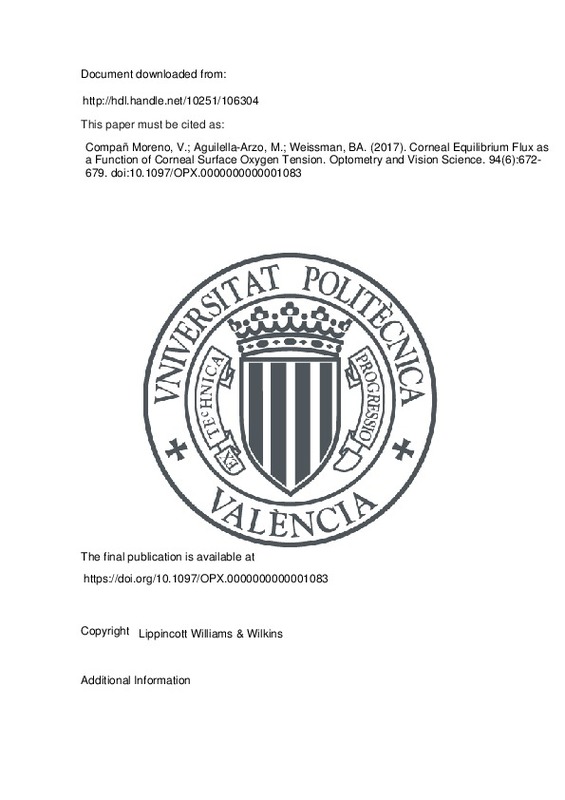JavaScript is disabled for your browser. Some features of this site may not work without it.
Buscar en RiuNet
Listar
Mi cuenta
Estadísticas
Ayuda RiuNet
Admin. UPV
Corneal Equilibrium Flux as a Function of Corneal Surface Oxygen Tension
Mostrar el registro sencillo del ítem
Ficheros en el ítem
| dc.contributor.author | Compañ Moreno, Vicente
|
es_ES |
| dc.contributor.author | Aguilella-Arzo, Marcel
|
es_ES |
| dc.contributor.author | Weissman, Barry A.
|
es_ES |
| dc.date.accessioned | 2018-07-26T07:09:50Z | |
| dc.date.available | 2018-07-26T07:09:50Z | |
| dc.date.issued | 2017 | es_ES |
| dc.identifier.issn | 1040-5488 | es_ES |
| dc.identifier.uri | http://hdl.handle.net/10251/106304 | |
| dc.description.abstract | [EN] Purpose Oxygen is essential for aerobic mammalian cell physiology. Oxygen tension (PO2) should reach a minimum at some position within the corneal stroma, and oxygen flux should be zero, by definition, at this point as well. We found the locations and magnitudes of this ¿corneal equilibrium flux¿ (xmin) and explored its physiological implications. Methods We used an application of the Monod kinetic model to calculate xmin for normal human cornea as anterior surface PO2 changes from 155 to 20 mmHg. Results We find that xmin deepens, broadens, and advances from 1.25 ¿m above the endothelial¿aqueous humor surface toward the epithelium (reaching a position 320 ¿m above the endothelial¿aqueous humor surface) as anterior corneal surface PO2 decreases from 155 to 20 mmHg. Conclusions Our model supports an anterior corneal oxygen flux of 9 ¿L O2 · cm¿2 · h¿1 and an epithelial oxygen consumption of approximately 4 ¿L O2 · cm¿2 · h¿1. Only at the highest anterior corneal PO2 does our model predict that oxygen diffuses all the way through the cornea to perhaps reach the anterior chamber. Of most interest, corneal oxygen consumption should be supported down to a corneal surface PO2 of 60 to 80 mmHg but declines below this range. We conclude that the critical oxygen tension for hypoxia induced corneal swelling is more likely this range rather than a fixed value. | es_ES |
| dc.language | Inglés | es_ES |
| dc.publisher | Lippincott Williams & Wilkins | es_ES |
| dc.relation.ispartof | Optometry and Vision Science | es_ES |
| dc.rights | Reserva de todos los derechos | es_ES |
| dc.subject | Cornea | es_ES |
| dc.subject | Monod kinetics model | es_ES |
| dc.subject | Oxygen consumption | es_ES |
| dc.subject | Oxygen flux | es_ES |
| dc.subject | Oxygen tension | es_ES |
| dc.subject.classification | MAQUINAS Y MOTORES TERMICOS | es_ES |
| dc.subject.classification | FISICA APLICADA | es_ES |
| dc.title | Corneal Equilibrium Flux as a Function of Corneal Surface Oxygen Tension | es_ES |
| dc.type | Artículo | es_ES |
| dc.identifier.doi | 10.1097/OPX.0000000000001083 | es_ES |
| dc.rights.accessRights | Abierto | es_ES |
| dc.contributor.affiliation | Universitat Politècnica de València. Departamento de Termodinámica Aplicada - Departament de Termodinàmica Aplicada | es_ES |
| dc.description.bibliographicCitation | Compañ Moreno, V.; Aguilella-Arzo, M.; Weissman, BA. (2017). Corneal Equilibrium Flux as a Function of Corneal Surface Oxygen Tension. Optometry and Vision Science. 94(6):672-679. doi:10.1097/OPX.0000000000001083 | es_ES |
| dc.description.accrualMethod | S | es_ES |
| dc.relation.publisherversion | https://doi.org/10.1097/OPX.0000000000001083 | es_ES |
| dc.description.upvformatpinicio | 672 | es_ES |
| dc.description.upvformatpfin | 679 | es_ES |
| dc.type.version | info:eu-repo/semantics/publishedVersion | es_ES |
| dc.description.volume | 94 | es_ES |
| dc.description.issue | 6 | es_ES |
| dc.relation.pasarela | S\350964 | es_ES |







![[Cerrado]](/themes/UPV/images/candado.png)

